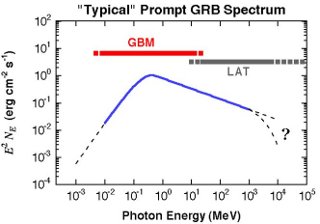Typical Prompt GRB Spectrum: The typical spectrum of a gamma burst spans the spectral range of two instruments on the Fermi Space Telescope: the Gamma-ray Burst Monitor (GBM) and Large Area Telescope (LAT).
Credit: NASA
Taking a spectrum allows you to determine the abundance of metals in space environments and this gets at the questions I am trying to answer. So instead of trying to answer “What is a gamma-ray burst?”, I think “What can I do with the light it produces?” But I’m not just a theorist – I appreciate what it takes to build the device which allows you to get that little piece of information you’re seeking. When I look at satellites and how they work, it’s just as exciting to me as what it takes to launch them and operate them. What I’ve been pursuing in the last few years is the development of new detectors for satellites so the next generation can find a way to use the light we get from gamma-ray bursts and learn the answers to these questions.
Many years ago our understanding of gamma-ray bursts was so limited we thought they could have been located anywhere, from the edge of the outer solar system to the most distant reaches of the Universe. Compton Gamma Ray Observatory, BeppoSAX, HETE-2, Swift Multiwavelength Observatory, and Fermi Gamma-ray Space Telescope missions helped answer some of these questions. But there is much more research to be done. We are still developing models for understanding the origins and physics of GRBs. We can use observations of GRBs to test theoretical predictions, for instance, about the nature of the last stages of supernovae. In some cases, it’s expected that the observations and the theory will not agree: the theories may need modification, or there may be new physical principles indicated that were not previously accounted for.


